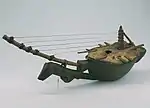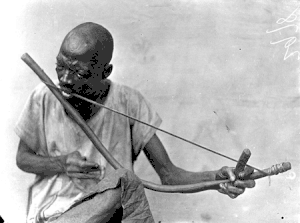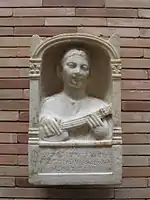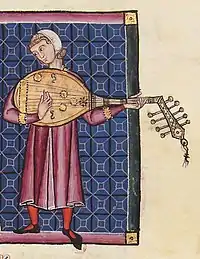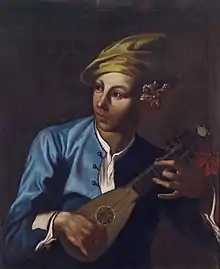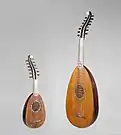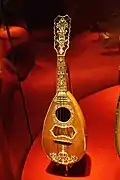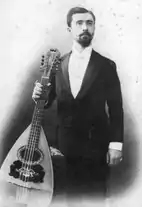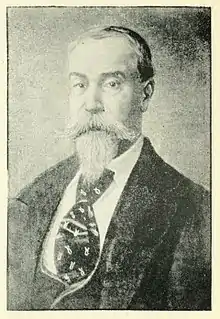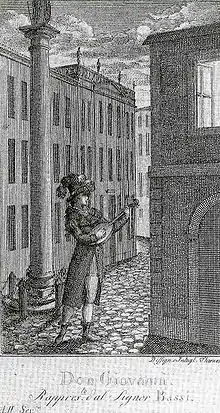
The mandolin is a modern member of the lute family, dating back to Italy in the 18th century. The instrument was played across Europe but then disappeared after the Napoleonic Wars. Credit for creating the modern bowlback version of the instrument goes to the Vinaccia family of Naples. The deep bowled mandolin, especially the Neapolitan form, became common in the 19th century, following the appearance of an international hit, the Spanish Students. They toured Europe and America, and their performances created a stir that helped the mandolin to become widely popular.
Although the modern instruments date to the 18th century, ancestral instruments of similar construction and range, the mandore and gittern, were used across Europe (including Spain, Italy, England, France, Germany and Poland) centuries earlier. These instruments developed from short-handled lutes that entered Christian Europe from Muslim Sicily and Spain. Muslims picked these instruments in Central Asia, calling them barbat and oud. Residents of Asia were playing them as far back as the 2nd century A.D.
Early precursors
Dating to c. 13,000 BC, a cave painting in the Trois Frères cave in France depicts what some believe is a musical bow, a hunting bow used as a single-stringed musical instrument.[2][3] From the musical bow, families of stringed instruments developed; since each string played a single note, adding strings added new notes, creating bow harps, harps and lyres.[4] In turn, this led to being able to play dyads and chords. Another innovation occurred when the bow harp was straightened out and a bridge used to lift the strings off the stick-neck, creating the lute.[5]
This picture of musical bow to harp bow is theory and has been contested. In 1965 Franz Jahnel wrote his criticism stating that the early ancestors of plucked instruments are not currently known.[6] He felt that the harp bow was a long cry from the sophistication of the 4th-century BC civilization that took the primitive technology and created "technically and artistically well made harps, lyres, citharas and lutes."[6]
First lutes
Musicologists have put forth examples of that 4th-century BC technology, looking at engraved images that have survived. The earliest image showing a lute-like instrument came from Mesopotamia prior to 3000 BC.[10] A cylinder seal from c. 3100 BC or earlier (now in the possession of the British Museum) shows what is thought to be a woman playing a stick lute.[10][11] From the surviving images, theorists have categorized the Mesopotamian lutes, showing that they developed into a long variety and a short.[12] The line of long lutes may have developed into the tamburs and pandura.[13] The line of short lutes was further developed to the east of Mesopotamia, in Bactria, Gandhara, and Northwest India, and shown in sculpture from the 2nd century BC through the 4th or 5th centuries AD.[14][15][16]
Persian barbat, Arab oud
Andalusia
Bactria and Gandhara became part of the Sasanian Empire (224–651 AD). Under the Sasanians, a short almond shaped lute from Bactria came to be called the barbat or barbud, which was developed into the later Islamic world's oud or ud.[18] When the Moors conquered Andalusia in 711 AD, they brought their ud along, into a country that had already known a lute tradition under the Romans, the pandura.
During the 8th and 9th centuries, many musicians and artists from across the Islamic world flocked to Iberia.[20] Among them was Abu l-Hasan ‘Ali Ibn Nafi‘ (789–857),[21][22] a prominent musician who had trained under Ishaq al-Mawsili (d. 850) in Baghdad and was exiled to Andalusia before 833 AD. He taught and has been credited with adding a fifth string to his oud[18] and with establishing one of the first schools of music in Córdoba.[23]
By the 11th century, Muslim Iberia had become a center for the manufacture of instruments. These goods spread gradually to Provence, influencing French troubadours and trouvères and eventually reaching the rest of Europe.
From Sicily to Germany
Beside the introduction of the lute to Spain (Andalusia) by the Moors, another important point of transfer of the lute from Arabian to European culture was Sicily and the earlier Emirate of Sicily, where it was brought either by Byzantine or later by Muslim musicians.[24] There were singer-lutenists at the court in Palermo following the Norman conquest of the island from the Muslims, and the lute is depicted extensively in the ceiling paintings in the Palermo’s royal Cappella Palatina, dedicated by the Norman King Roger II of Sicily in 1140.[24] His Hohenstaufen grandson Frederick II, Holy Roman Emperor (1194 - 1250) continued integrating Muslims into his court, including Moorish musicians.[25] Frederick II made visits to the Lech valley and Bavaria between 1218 and 1237 with a "Moorish Sicilian retinue."[26] By the 14th century, lutes had disseminated throughout Italy and, probably because of the cultural influence of the Hohenstaufen kings and emperor, based in Palermo, the lute had also made significant inroads into the German-speaking lands. By 1500 the valley and Füssen had several lute-making families, and in the next two centuries the area hosted "famous names of 16th and 17th century lutemaking".[27]
European lute beginnings
A distinct European tradition of lute development is noticeable in pictures and sculpture from the 13th century onward. As early as the beginning of the 14th century, strings were doubled into courses on the miniature lute or gittern, used throughout Europe. The small soundhole shaped like a "3" or a "W", typical of Muslim-made instruments and seen in the Cantigas de Santa Maria illustrations on instruments played by Europeans, were not typical of European instruments.[17] Instead the European instruments largely used a C-, D- or B-shaped soundhole, or a round soundhole, which might be covered with a rose decoration.[17] The gittern is first seen in 13th century art. It developed into the mandore (French name) by the late 16th century and was known in German as the mandoer, Spanish vandola, and Italian mandola.[28]
Development in Italy, birth of Neapolitan mandolin
The instruments predating the 18th century mandolinos, the gittern, mandore, mandora and mandola were instruments averaging 300-400 mm in scale length. As the term mandolino came into use in the 1700s to describe the baroque version (315 mm scale length) of these earlier small instruments, the terms mandola and mandora began to be applied to instruments nearly double the mandolino's size. Neapolitan mandolins were from 315-330 mm scale length.
When the word "mandolin" is said in the 21st century, it usually refers to an instrument with 8 strings tuned in fifths, such as the Neapolitan mandolin or the American bluegrass mandolin. It is also commonly thought that mandolino is a diminutive of mandola, and that therefore the mandolino was a smaller development of the mandola.[30]
The path from mandola to the modern mandolin was not simple; in the late 19th and early 20th centuries, there were varieties of mandolin with different characteristics. As historians sorted instruments and traditions, it became understood that the current mandolin may not be a true descendant of the mandola, and that it may represent a blending of instrument-making traditions.
The mandore or mandola of the 16th and 17th centuries was not the final form. It was redesigned in Northern Italy. The mandola had a flat soundboard with glued-on bridge, a peg box angled backwards, and lateral tuning pegs.[30] The new instrument was smaller but retained the flat soundboard with glued-on bridge,[30] and was called the little mandola or "mandolino."[30] From it came the Milanese mandolin and later the Lombardy mandolin, with both instruments keeping the glued-on bridge. The catgut-strung mandolino and later Milanese and Lombardy mandolins were strung in 4, 5 or 6 courses tuned in fourths: e′–a′–d″–g″, b–e′–a′–d″–g″ or g–b–e′–a′–d″–g″, and played finger-style.[31]
German historian Konrad Wölki said that these fourths-tuned mandolins were the instruments to which the name mandolino originally applied, but as other small, plucked and (to him) unrelated instruments were developed in Italy, the name transferred across to them.[30] Wölki felt that the Florentine and Neapolitan mandolins were "not genuine descendants of the mandola."[30] He considered the chitarra battente to be a prototype for Neapolitan mandolin (because of the shape of the soundboard and the way strings were attached to the bottom, and because it had a flat, angled pegboard instead of peghead) and the Florentine mandolin (because of the longer neck).[30]
Musician and musical historian Alex Timmerman does not draw hard lines in his chart, "The Italian Mandolin, its evolution, nomenclature and types." He makes an effort to show relations between the generations of the instruments, from the mandola in the 1650s to the mandolins of the present day. The chart shows mandolinos as predecessors to the lines of mandolins, and possible points-of-blending of instrument features.[32]
In one example on Timmerman's chart, makers of the mandolino (with bridge glued to the soundboard) blended it with the chittara battuta which had a floating bridge. The floating bridge was held to the soundboard by pressure from the strings attached to the instrument's body. The chitarra battente also had a soundboard that bent upwards to withstand string pressure of metal strings, instead of the mandolino's flat soundboard.[32] Instruments in this tradition include the Neapolitan mandolin, Roman mandolin, Genovés mandolin and Sicilian mandolin.[32] Similarly, the chart shows a possible blending of the mandolino and colascione to create the longer-necked Florentine mandolin, the Brescian mandolin and the Cremonese mandolin, all which retained the mandola's glued down bridge.[32]
Vinaccia family, first metal-string mandolins
The first evidence of modern metal-string mandolins is from literature regarding popular Italian players who travelled through Europe teaching and giving concerts. Notable are Gabriele Leone, Giovanni Battista Gervasio, Pietro Denis, who travelled widely between 1750 and 1810.[34][35] This, with the records gleaned from the Italian Vinaccia family of luthiers in Naples, Italy, led some musicologists to believe that the modern steel-string mandolins were developed in Naples by the Vinaccia family.
Not limited to mandolins, the Vinaccias made stringed instruments, including violins, cellos, guitars, mandolas and mandolins. Noted members of the family who made mandolins are known today from labels inside of surviving instruments and include Vincenzo, Giovanni, Domenico, and Antonio (and his sons Gaetano and Gennaro, grandson Pasquale and great-grandsons Gennaro and Achille). The mandolins they made changed over generations, from mandolinos with flat soundboards and gut-strings, through mandolins with a bent soundboard and bronze or bronze-and-gut strings, into mandolins with bent soundboards that used steel or steel-and-bronze strings.
Pasquale Vinaccia (1806–c. 1882), modernized the mandolin, adding features, creating the Neapolitan mandolin c. 1835.[33][36][37] Pasquale remodeled, raised and extended the fingerboard to 17 frets, introduced stronger wire strings made of high-tension steel and substituted a machine head for the friction tuning pegs, then standard.[36][38] The new wire strings required that he strengthen the mandolin's body, and he deepened the mandolin's bowl, giving the tonal quality more resonance.[36] He did not introduce the bent soundboard, as it was present in some of the instruments made by the previous generation for bronze strings.
Calace, Embergher and others
Other luthiers who built mandolins included Raffaele Calace (1863 onwards) in Naples, Luigi Embergher[39] (1856–1943) in Rome and Arpino, the Ferrari family (1716 onwards, also originally mandolino makers) in Rome, and De Santi (1834–1916) in Rome. Names of other mandolin luthiers from this era include Carlo Guadagnini (son of Giovanni Battista Guadagnini) and Gaspare Ferrari, both of whom have instruments in the collection of the Music Museum in Venice.[40] The Neapolitan style of mandolin construction was adopted and developed by others, notably in Rome, giving two distinct but similar types of mandolin – Neapolitan and Roman.[41]
Rising and falling fortunes
First wave
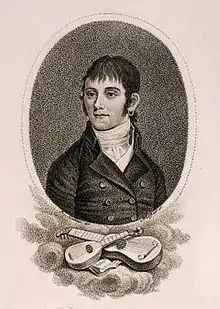
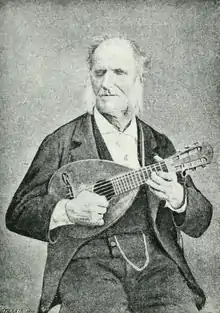
The transition from the mandolino to the mandolin began around 1744 with the designing of the metal-string mandolin by the Vinaccia family, 3 brass strings and one of gut, using friction tuning pegs on a fingerboard that sat "flush" with the sound table.[43] The mandolin grew in popularity over the next 60 years, in the streets where it was used by young men courting and by street musicians, and in the concert hall.[44] After the Napoleonic Wars of 1815, however, its popularity began to fall.[45] The 19th century produced some prominent players, including Bartolomeo Bortolazzi of Venice and Pietro Vimercati.[46] However, professional virtuosity was in decline,[46] and the mandolin music changed as the mandolin became a folk instrument; "the large repertoire of notated instrumental music for the mandolino and the mandoline was completely forgotten". The export market for mandolins from Italy dried up around 1815, and when Carmine de Laurentiis wrote a mandolin method in 1874, the Music World magazine wrote that the mandolin was "out of date."[47] Salvador Léonardi mentioned this decline in his 1921 book, Méthode pour Banjoline ou Mandoline-Banjo, saying that the mandolin had "lost for a time the great popularity it once enjoyed."[48]
It was during this slump in popularity (specifically in 1835) that Pasquale Vinaccia made his modifications to the instrument that his family made for generations, creating the Neapolitan mandolin.[43] The mandolin was largely forgotten outside Italy by that point, but the stage was set for it to become known again, starting with the Paris Exposition in 1878.[49]
Second wave, the Golden Age of mandolins
Beginning with the Paris Exposition of 1878, the instrument's popularity began to rebound. The Exposition was one of many stops for the Estudiantes Españoles (Spanish Students).[52] There has been confusion regarding this group.
The original Estudiantes Española or Estudiantina Española was a group of 64 students formed by 26 February 1878, principally from Madrid colleges.[53] They dressed in historical clothing, representing ancient sophists of Salamanca and Alcala and traveled to Paris for Carnival staying from March 2 through March 15.[53] This early group of students played flutes, guitars violins, bandurrias, flutes and tambourines.[53] This early group was led by Ildefonso de Zabaleta (president) and Joaquin de Castañeda (vice president).[53] The group performed before large audiences in Paris (reports of 10,000 and 56,000 people showing up for a night's entertainment were reported).[53]
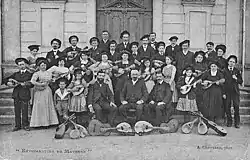
Their success in Paris preceded a second group of Spanish performers, known as the Esudiantina Figaro or Esudiantina Española Figaroa (Figaro Band of Spanish Students).[54] This group was founded by Dionisio Granados and toured Europe dancing and playing guitars, violins and the bandurria, which became confused with the mandolin.[52][55][56]
Along with their energy and the newfound awareness of the instrument created by the day's hit sensation, a wave of Italian mandolinists travelled Europe in the 1880s and 1890s and in the United States by the mid-1880s, playing and teaching their instrument.[57] The instrument's popularity continued to increase during the 1890s and mandolin popularity was at its height in the "early years of the 20th century."[58] Thousands were taking up the instrument as a pastime, and it became an instrument of society, taken up by young men and women.[58] Mandolin orchestras were formed worldwide, incorporating not only the mandolin family of instruments, but also guitars, double basses and zithers.
That era (from the late 19th century into the early 20th century) has come to be known as the "Golden Age" of the mandolin.[59] The term is used online by mandolin enthusiasts to name the time period when the mandolin had become popular, when mandolin orchestras were being organized worldwide, and new and high-quality instruments were increasingly common.
After the First World War, the instrument's popularity again fell, though gradually.[60] Reasons cited include the rise of Jazz, for which the instrument was too quiet. Also, modern conveniences (phonograph records, bicycle and automobiles, outdoor sports) competed with learning to play an instrument for fun.[60]
Aftermath
The second decline was not as complete as the first. Thousands of people had learned to play the instrument. Even as the second wave of mandolin popularity declined in the early 20th century, players began using new versions of the mandolin in new forms of music.[61] Luthiers created the resonator mandolin, the flatback mandolin, the carved-top or arched-top mandolin, the mandolin-banjo and the electric mandolin. Musicians began playing it in Celtic, Bluegrass, Jazz and Rock-n-Roll styles — and Classical too.
See also
References
- ↑ Sparks 2003, pp. 3–4
- ↑ Campen, Ank van. "The music-bow from prehistory till today". HarpHistory.info. Retrieved March 26, 2015.
A cave-painting in the "Trois Frères" cave in France dating from about 15,000 years ago. The magician-hunter plays the musical bow.
- ↑ "Trois Freres Cave". Retrieved March 27, 2015.
- ↑ Dumbrill 1998, p. 179, 231, 235–236, 308–310
- ↑ Dumbrill 1998, p. 308–310
- 1 2 Jahnel, Franz (1965). Manual of Guitar Technology: The History and Technology of Plucked String Instruments (Fachbuchreihe Das Musikinstrument, Bd. 37). p. 15. ISBN 0-933224-99-0.
There have been some uncertain presumptions concerning the "invention" of the bowed harp...The "musical bow" conjectured by many music scholars is not definitely recognizable in any cave paintings. The fact that some African negroes held the end of their bow shaped harp in their mouths in order to improve the tone...should not be taken as proof that the first European bowmen were also conversant with the musical bow.
- ↑ https://m.flickr.com/#/photos/julio-claudians/8098646683/ Flicker based photo of the museum information sign for the stele. Circa 2nd century A.D memorial stele from Augusta Emerita in modern Spain for a Roman boy, Lutaia Lupata, showing him with his pandurium, the Roman variant of the Greek Pandura. Kept at the Museo Arqueologico, Merida, Spain.
- ↑ Edmondson, Jonathan; Basarrate, Trinidad Nogales; Trillmich, Walter (2001). Imagen y memoria: Monumentos funerarios con retratos en la colonia Augusta Emerita (in Spanish). Real Academia de la Historia. p. 144. ISBN 978-84-89512-92-4.
- ↑ "Estela de Lutatia Lupata". Museo Nacional de Arte Romano. Retrieved 8 January 2018.
- 1 2 Dumbrill 1998, p. 321
- ↑ "cylinder seal". British Museum. Retrieved 25 April 2019.
- ↑ Dumbrill 1998, p. 310
- ↑ Dumbrill, Richard J. (2005). The Archaeomusicology of the Ancient Near East. Victoria, British Columbia: Trafford Publishing. pp. 319–320. ISBN 1-4120-5538-5.
The long-necked lute in the OED is orthographed as tambura; tambora, tamera, tumboora; tambur(a) and tanpoora. We have an Arabic Õunbur ; Persian tanbur ; Armenian pandir ; Georgian panturi. and a Serbo-Croat tamburitza. The Greeks called it pandura; panduros; phanduros; panduris or pandurion. The Latin is pandura. It is attested as a Nubian instrument in the third century BC. The earliest literary allusion to lutes in Greece comes from Anaxilas in his play The Lyre-maker as 'trichordos'... According to Pollux, the trichordon (sic) was Assyrian and they gave it the name pandoura...These instruments survive today in the form of the various Arabian tunbar...
- ↑ "Encyclopaedia Iranica - Barbat". Iranicaonline.org. 1988-12-15. Retrieved 2015-03-13.
- ↑ "Five Celestial Musicians". Lacma.org. Archived from the original on 2017-10-10. Retrieved 15 May 2017. Views 3 & 4 show a musician playing a 4th- to 5th-century lute-like instrument, excavated in Gandhara, and part of a Los Angeles County Art Museum collection of Five Celestial Musicians
- ↑ "Bracket with two musicians 100s, Pakistan, Gandhara, probably Butkara in Swat, Kushan Period (1st century-320)". The Cleveland Museum of Art. Retrieved March 25, 2015.
- 1 2 3 Rault, Christian. "The emergence of new approaches to plucked instruments, 13th - 15th centuries". christianrault.com. Retrieved 18 November 2016.
Muslim constructional features:W shaped sound holes.
- 1 2 3 4 "Encyclopaedia Iranica - Barbat". Iranicaonline.org. 1988-12-15. Retrieved 2012-02-04.
- ↑ J.W. McKinnon "Pandoura" in New Grove Dictionary of Musical Instruments Vol 3 p 10 ed S. Sadie (Macmillan Press, London 1984).
- ↑ Menocal, María Rosa; Scheindlin, Raymond P.; Sells, Michael Anthony, eds. (2000), The Literature of Al-Andalus, Cambridge University Press
- ↑ Gill, John (2008). Andalucia: A Cultural History. Oxford University Press. p. 81. ISBN 978-01-95-37610-4.
- ↑ Lapidus, Ira M. (2002). A History of Islamic Societies. Cambridge University Press. p. 311. ISBN 9780521779333.
- ↑ Davila, Carl (2009), Fixing a Misbegotten Biography: Ziryab in the Mediterranean World, Al-Masaq: Islam in the Medieval Mediterranean Vol. 21 No. 2
- 1 2 Colin Lawson and Robin Stowell, The Cambridge History of Musical Performance, Cambridge University Press, February 16, 2012
- ↑ Roger Boase, The Origin and Meaning of Courtly Love: A Critical Study of European Scholarship, Manchester University Press, 1977, p. 70-71.
- ↑ Edwards, Vane. "An Illustrated History of the Lute Part One". vanedwards.co.uk. Retrieved 4 April 2019.
Bletschacher (1978) has argued that this was due largely to the royal visits of Friedrich II with his magnificent Moorish Sicilian retinue to the towns in this valley between 1218 and 1237.
- ↑ Edwards, Vane. "An Illustrated History of the Lute Part Two". vanedwards.co.uk. Retrieved 4 April 2019.
By 1500 the first written records confirm the existence of several families making lutes as a trade in and around Füssen in the Lech valley. Most of the famous names of 16th and 17th century lutemaking seem to have come originally from around this small area of Southern Germany. By 1562 the Füssen makers were sufficiently well established to set up as a guild with elaborate regulations which have survived.(see Bletschacher, 1978, and Layer, 1978)
- ↑ The gitterns and mandores had typical scale lengths of 30 centimeters to 40 centimeters.Randel, Don Michael (2003-11-28). The Harvard Dictionary of Music. Harvard University Press reference library. Vol. 16. Harvard University Press (published 2003). p. 484. ISBN 978-0-674-01163-2.
Mandora, mandore, mandola [Fr. mandore; Ger. Mandoër, Mandürichen, Mandourlauten; It. Mandola; Sp. vandola]. (1) A lutelike instrument developed from the medieval *gittern....
- ↑ Challen, Chris (4 January 2009). "Photo 21 of 33 from Five course Mandolino & Case - Antonio Stradivari in Cremona 1680". mandolincafe.org. Retrieved 20 April 2019.
- 1 2 3 4 5 6 7 Wölki, Konrad (1984). Geschichte der Mandoline [History of the Mandolin] (in German). Translated by Harris, Keith. Arlington, Virginia: Plucked String. pp. 3–4.
- ↑ McDonald 2008, p. 8
- 1 2 3 4 Timmerman, Alex. The Italian Mandolin, its evolution, nomenclature and types (PDF) (Thesis).
[Chart by Alex Timmerman showing lines of mandolins and their relationships. The document is not all inclusive, but contains "the most distinguished instruments within the Italian Mandolin family.]"
- 1 2
Philip J. Bone (1914). The guitar and mandolin, Biographies of celebrated players and composers for these instruments. London: Schott and Company. pp. 220–221.
Pasquale Vinaccia of Naples, the perfector of the modern Italian mandolin. The name of Vinaccia is emblazoned amongst the most exalted of the world's stringed instrument makers, and it was the inventive genius of this member of the family — born July 20, 1806 in Naples, and died there in 1882 — that gave the instrument its steel strings and consequent machine head, who extended the compass of its fingerboard and enlarged and improved the tonal capabilities and qualities of the instrument.
- ↑ The New Grove Dictionary of Music and Musicians, Second Edition, edited by Stanley Sadie and others (2001)
- ↑ Sparks 2003, p. 218
- 1 2 3 Sparks 2003, p. 15–16
- ↑ "Information on Pasquale Vinaccia, violin maker in Naples, Italy". Amati.com. Archived from the original on 2015-06-27. Retrieved 26 June 2015.
- ↑ "The Bickford mandolin method". Archive.org. Retrieved 21 December 2014.
For the perfected form of the Neapolitan mandolin we are indebted entirely to the inventive genius of Pasquale Vinaccia (1806-1882), who gave us every point of difference between the antique and the modern forms. It was he who remodeled and extended the fingerboard; introduced wire strings and substituted the machine head.
- ↑ The Embergher mandolin, Ralf Leenen and Barry Pratt, 2004. ISBN 9073838312, 9789073838314
- ↑ "INSTRUMENTS". museodellamusica.com. Retrieved 19 May 2018.
- ↑ Sparks 2003
- ↑ Dossena, Luigi (7 September 2014). "Historia et imago Cremae. La vita di Giovanni Vailati, il Paganini del mandolino: dai caffè cremaschi ai teatri d'Europa [translation: Historia et imago Cremae. The life of Giovanni Vailati, the Paganini of the mandolin: from the cremaschi cafés to the theaters of Europe]". cremonaonline.it. Retrieved 11 June 2018.
...on December 2, 1852 in Parma at the Regio theater he performed a single string music from his mandolin, on a Lombard-type mandolin inspired by sixteenth-century instruments still unformed and rough. It was a soprano lute, very small, having the semblance of a paunchy half-egg which he later replaced with a mandolin inspired by Hispanic Bandurria- type models...
- 1 2 Sparks 2003, p. 15
- ↑ Sparks 2003, p. 1, 9–10, 14–15
- ↑ Sparks 2003, p. 1
- 1 2 Sparks 2003, p. 1–3
- ↑ Biaggi, G. A. (March 20, 1875). "The Lute and the Mandolin, with some remarks on Sig. Giovanni Vailati in connection with them (reprint from La Gazetta Musicale in Milan)". The Musical World. Vol. 53, no. 12. London: William Duncan Davison. pp. 204–205. Retrieved September 20, 2015.
Though the instrument is entirely out of fashion, the house of Ricordi published last year [1874] at Milan A Metodo per Mandolino, a well planned work, well carried out, by Sic. Carmine De-Laurentiis.
- ↑ Salvador Léonardi, Méthode pour Banjoline ou Mandoline-Banjo, Paris, 1921
- ↑ Sparks 2003, p. 21
- ↑ Martín Sárraga, Félix O. (2016). "Crónica del viaje de la Estudiantina Española al Carnaval de París de 1878 según la prensa de la época". Tvnae Mvndi. academia.edu. 2: 7, 11, 44. Retrieved 9 October 2016.
(p.7) El de la estudiantina española, compuesta por 64 personas y que está en París, es muy bello y gusta mucho... (p.11) A las nueve los 64 jóvenes que forman la estudiantina llegaron a nuestra casa atravesando con gran dificultad por enmedio del público reunido delante de nuestro hotel... (p.44) La estudiantina se compone de 64 jóvenes que, según las noticias más fidedignas, y desnudas [de] algún tanto de la exageración francesa que los ha ennoblecido con antiguos titulos, por lo menos de hidalguía, proceden en gran parte del Conservatorio y de la Facultad de Medicina, que fue siempre la que dió más estudiantes a su Tuna. [Translation]:(p.7)That of the Spanish Estudiantina, composed of 64 people and is in Paris is very beautiful and very much like... (p.11) At nine the 64 young people who form the estudiantina came to our house with great difficulty through the middle of the public gathered in front of our hotel... (p.44) The estudiantina consists of 64 young people who, according to the most reliable news, and bare [of] somewhat of French exaggeration that has ennobled with old titles, at least hidalguía, comes in much of the Conservatory and the School of Medicine, which was always the one that gave more students to their Tuna.
- ↑ Martín Sárraga, Félix O. (2016). "Crónica del viaje de la Estudiantina Española al Carnaval de París de 1878 según la prensa de la época". Tvnae Mvndi. academia.edu. 2: 15–16. Retrieved 9 October 2016.
A las tres el café Riche era el centro de una aglomeración de gentes de que nada puede dar idea puesto que el inspector de policía especialmente encargado de proteger a la estudiantina la ha evaluado en su parte oficial en 56.000 personas. [At three the Café Riche was the center of an agglomeration of people that nothing can give an idea as the police inspector in charge of protecting especially the estudiantina has evaluated its official part in 56,000 people.]
- 1 2 Sparks 2003, p. 20–29
- 1 2 3 4 5 Martín Sárraga, Félix O. (2016). "Crónica del viaje de la Estudiantina Española al Carnaval de París de 1878 según la prensa de la época". Tvnae Mvndi. academia.edu. 2: 7, 8, 14, 16, 39, 44, 46, 47. Retrieved 9 October 2016.
- ↑ Martin Sárraga, Felix O. (26 July 2015). "Apuntes sobre las giras europeas de la Estudiantina Fígaro". tunaemundi.com. Retrieved 10 October 2016.
Para comprender mejor el surgimiento de la Estudiantina Española Fígaro hemos necesariamente de recordar que muy posiblemente no hubiera existido si antes no se hubiera producido la creación de la Estudiantina Española con el fin de asistir al Carnaval de París de 1878... We say that the Spanish Estudiantina Figaro quite possibly would not exist if there were not produced before the creation and media coverage of the Spanish Estudiantina.[translation]: To better understand the emergence of the Spanish Estudiantina Figaro we have necessarily to remember that they most likely would not have existed had there not previously the Spanish Estudiantina been created in order to attend the Paris Carnival 1878... We say that the Spanish Estudiantina Figaro quite possibly would not exist if there were not produced before the creation and media coverage of the Spanish Estudiantina.
- ↑ Martin Sárraga, Felix O. (26 July 2015). "Análisis comparado de los integrantes de la Estudiantina Española Fígaro (1880 -1889". tunaemundi.com. Retrieved 10 October 2016.
Sabemos por diversas fuentes que la Fígaro fue fundada por Dionisio Granados... [Translation]: We know from various sources that Figaro was founded by Dionisio Granados...
- ↑ Martin Sárraga, Felix O. (26 July 2015). "Apuntes de la gira por la Península Ibérica de la Estudiantina Fígaro (1881 - 1890)". tunaemundi.com. Retrieved 10 October 2016.
La Estudiantina Española Fígaro, como publicara la prensa de 1882, "es una asociación de jóvenes profesores, músicos ..... se creó y constituyó en Madrid formando una magnífica banda de guitarras, bandurrias y violines que partió de allí en 1878 con el objeto de dar conciertos [Translation]: The Spanish Estudiantina Figaro, as published Press 1882, "is an association of young teachers, musicians ..... was created and established in Madrid forming a magnificent band of guitars, bandurrias and violins left there in 1878 with the concerts object
- ↑ Sparks 2003, p. 22–135
- 1 2 Sparks 2003, p. 96
- ↑ The Classical Mandolin Society, Classical Mandolin - A (Very) Brief Overview Archived 2015-01-25 at the Wayback Machine
- 1 2 Sparks 2003, p. 153–154
- ↑ Ian Pommerenke, The Mandolin in the early to mid 19th Century, Lanarkshire Guitar and Mandolin Association Newsletter, Spring 2007.
- Dumbrill, Richard J. (1998). The Archaeomusicology of the Ancient Near East. London: Tadema Press.
- McDonald, Graham (2008). The Mandolin Project. Australia: Jamison, A.C.T., Graham McDonald Stringed Instruments. ISBN 978-0-9804762-0-0.
- Sparks, Paul (2003). The Classical Mandolin. Oxford: Oxford University Press. ISBN 9780195173376.
